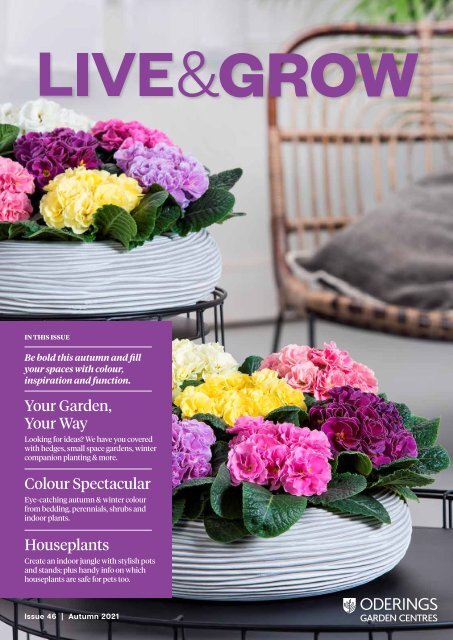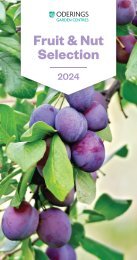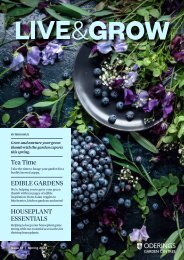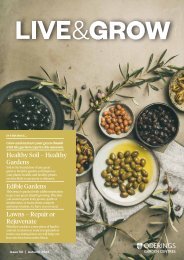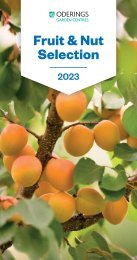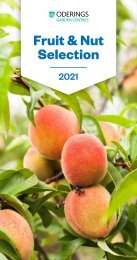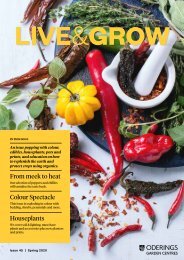Live & Grow Magazine 46
Our latest autumn magazine is full of ideas to keep your home and garden looking bright over the winter months.
Our latest autumn magazine is full of ideas to keep your home and garden looking bright over the winter months.
You also want an ePaper? Increase the reach of your titles
YUMPU automatically turns print PDFs into web optimized ePapers that Google loves.
IN THIS ISSUE<br />
Be bold this autumn and fill<br />
your spaces with colour,<br />
inspiration and function.<br />
Your Garden,<br />
Your Way<br />
Looking for ideas? We have you covered<br />
with hedges, small space gardens, winter<br />
companion planting & more.<br />
Colour Spectacular<br />
Eye-catching autumn & winter colour<br />
from bedding, perennials, shrubs and<br />
indoor plants.<br />
Houseplants<br />
Create an indoor jungle with stylish pots<br />
and stands; plus handy info on which<br />
houseplants are safe for pets too.<br />
Issue <strong>46</strong> | Autumn 2021
Autumn 2021<br />
What’s inside<br />
24<br />
4<br />
Oderings-<strong>Grow</strong>n Veggies<br />
Oderings’ fail-safe veggies to grow<br />
in autumn for a winter harvest.<br />
5<br />
6<br />
8<br />
10<br />
12<br />
How to Get Great Results<br />
Organically<br />
Robbie Yortt from Grosafe explains<br />
the importance of a special kind<br />
of seaweed.<br />
Oderings-<strong>Grow</strong>n Pansies<br />
& Violas<br />
A selection of new pansies and violas<br />
for pots, planters and hanging baskets.<br />
Oderings-<strong>Grow</strong>n Colourful<br />
Autumn<br />
Magnificent flowers and foliage, of<br />
all colours, for a brilliant display this<br />
autumn and winter.<br />
Powering Up<br />
Ensuring a reliable supply during<br />
an international pandemic is not<br />
always easy, and the Oamaru-based<br />
company faced a real challenge.<br />
Pet-Safe Houseplants<br />
Oderings help by providing a list of<br />
pet-safe houseplants to ensure your<br />
furry friends come first.<br />
14<br />
16<br />
17<br />
18<br />
20<br />
22<br />
24<br />
Houseplant Cool Weather<br />
Essentials<br />
Our favourite products to care for your<br />
houseplants in these cooler seasons.<br />
<strong>Grow</strong> Bulbs Lighten Up Your<br />
Urban Jungle<br />
<strong>Grow</strong> in style using our new grow bulbs,<br />
which easily fit into your home light fittings.<br />
Houseplant Décor with Plant<br />
Stands & <strong>Grow</strong>ing Frames<br />
Elevate your houseplants with new-look<br />
plant frames and a stand they deserve.<br />
Oderings-<strong>Grow</strong>n Houseplants<br />
We have you covered with the hot and<br />
in-demand houseplants this autumn.<br />
Hydro Clay Propagation<br />
Also known as leca; whatever you know<br />
it as, it’s an easy method for quick,<br />
successful propagation.<br />
Ceramic Décor<br />
The perfect accompaniments for<br />
houseplants. This new selection of pots<br />
is sure to delight.<br />
Windowsill Gardens<br />
Anyone can successfully grow a windowsill<br />
garden, and the cooler months of autumn<br />
and winter are the perfect time to start.<br />
26<br />
27<br />
28<br />
30<br />
Prepare your Lawn Now for<br />
Spring<br />
Do not wait for spring as so many do; early<br />
autumn is the very best time to get your<br />
lawn healthy, weed-free, thickened and<br />
looking great.<br />
Oderings-<strong>Grow</strong>n Primula<br />
Rosebuds<br />
Joining the existing range are six new<br />
colours in the ever-popular Rosebud series.<br />
Camellias, Rhodos & Azaleas<br />
Our top choices for the showiest plants for<br />
gardens of all sizes.<br />
Small Plants for Small<br />
Gardens<br />
With homes getting smaller, you can still<br />
create a stunning small garden with our<br />
little garden tips and plant selections.<br />
32 Hedging<br />
Selecting the right hedge is very important,<br />
and we have a few guidelines to help you<br />
decide.<br />
34<br />
35<br />
Performance Naturals<br />
All Purpose Fertilisers<br />
A breakthrough range of 100% natural<br />
products.<br />
Winter Companion Planting<br />
We cover the more cold-hardy companion<br />
plants for autumn and winter gardens.
Welcome back<br />
I am often asked “What is the secret to a successful garden?” and I always<br />
answer that healthy soil builds healthy plants.<br />
If you think about it, we are continually using products to keep ourselves and<br />
our environment happy and healthy; the same principle applies to gardens.<br />
The key thing that gives your garden life is the soil they are planted in. With<br />
healthy soil, we get strong, healthy plants that are less susceptible to pests<br />
and diseases. If you are looking at giving back to your soil, have a read of<br />
the articles on pages 5 and 26, and pop in to see us about green crops,<br />
all of which are natural ways to give nutrients back to your soil.<br />
As expected, houseplants remain a huge trend, and considering how much<br />
time we are spending indoors, growing houseplants is an easy way to make<br />
a house feel like a home. Pages 12 through 23 feature beautiful pots, plant<br />
stands, new plant support frames, and a new, innovative grow bulb to get<br />
your houseplants, cuttings and propagating stations cranking over the lowlight<br />
months. If you love houseplants or are just beginning your houseplant<br />
obsession, we have you covered.<br />
I think this issue of <strong>Live</strong> & <strong>Grow</strong> answers many of the burning questions we<br />
get asked at this time of year. We take you through our top picks for Azaleas,<br />
Camellias and Rhododendrons, shrubs and tree choices for smaller gardens,<br />
and if you have wanted to plant a hedge but don't know where to start, the<br />
article on pages 32 and 33 is a must-read for you.<br />
I am already planning and planting my autumn veggie patch. There are so<br />
many hardy winter veggies, and I love the new Cauliflower Twister on page 4.<br />
Make sure if you plant brassicas, you incorporate lime into the soil. Lime helps<br />
prevent clubroot, and by integrating lime with brassicas (broccoli, cabbage,<br />
cauliflower, etc.), it can double the head size of this crop.<br />
So, whether you are growing indoors or out, we hope this<br />
magazine helps answer some questions, teaches you<br />
something you didn't know, and inspires your passion<br />
for gardening in the months ahead.<br />
Happy Gardening<br />
Pamela Smith<br />
Editor<br />
18<br />
Bulb Image<br />
17<br />
Oderings<br />
<strong>Live</strong> & <strong>Grow</strong><br />
Editor Pamela Smith<br />
Advertising Nicola McKee<br />
Design Iva Hrubosova<br />
Contributors Pamela Smith,<br />
Daniel Hart, Jenna Zanchettin<br />
Contact Us<br />
Oderings Garden Centres Head Office<br />
92 Stourbridge Street, Spreydon,<br />
Christchurch 8024<br />
PO Box 33125, Barrington<br />
Christchurch 8244<br />
P: 03 332 9099 F: 03 332 1585<br />
info@oderings.co.nz<br />
www.oderings.co.nz<br />
Store Locations<br />
Barrington 03 332 9099<br />
92 Stourbridge St, Christchurch<br />
Cashmere 03 338 5193<br />
205 Cashmere Rd, Christchurch<br />
Linwood 03 982 3498<br />
485 Linwood Ave, Christchurch<br />
Philpotts 03 385 2386<br />
116 Philpotts Rd, Christchurch<br />
Yaldhurst 03 342 9198<br />
20 West Coast Rd, Christchurch<br />
Cambridge 07 855 6064<br />
1689 Cambridge Rd, RD3, Hamilton<br />
Havelock North 06 877 3051<br />
57 Brookvale Rd<br />
Napier 06 844 8105<br />
11 Allen Rd, Pakowhai<br />
Palmerston North 06 356 6797<br />
136 Cook St, West End<br />
© All content and images in this publication are subject to<br />
copyright and reproduction of any part is strictly prohibited.
ODERINGS-GROWN<br />
Broccolini<br />
Broccolini is a natural cross between broccoli and<br />
Gai Lan or Chinese broccoli, with spear-shaped,<br />
thin, tender, vibrant green stems with loose small<br />
clusters of florets that resemble broccoli. Compared<br />
to common broccoli, the flavour of broccolini is<br />
understated, mild, peppery and subtly sweet.<br />
Veggies<br />
NEW<br />
2021<br />
Cauliflower Twister<br />
Twister Cauliflower is an F1 hybrid with large, dense heads and<br />
outstanding wrapping ability. It is unique, with the outer leaves<br />
“twisting” to cover and protect the head keeping them beautiful,<br />
uniform and bright white. Performs well in the heat or cool and<br />
seems to prefer heavier soils. 75 days to maturity.<br />
Lettuce Drunken Woman<br />
With a fringed head, Drunken Woman is an Italian<br />
heirloom lettuce that produces attractive bright<br />
green leaves with ruffled, almost frizzy, edges dipped<br />
in deep bronze. It is a popular variety of lettuce,<br />
particularly with beginner gardeners, because it is<br />
very easy to grow and slow to bolt.<br />
Spinach Perpetual<br />
From the chard family, perpetual spinach is very<br />
similar to the true spinach in flavour. We prefer it as<br />
it is much easier to grow and far more vigorous than<br />
true spinach. It also has the advantage of constantly<br />
producing a new crop when picked and so is ideally<br />
suited to gardening in a small space.<br />
4
®<br />
HOW TO GET<br />
GREAT RESULTS<br />
ORGANICALLY<br />
Smarter seaweed solutions are now available<br />
to New Zealand growers. Robbie Yortt from<br />
Grosafe explains the importance of a special<br />
kind of seaweed and advanced patented<br />
extraction methods.<br />
New Zealand’s commercial growers were the first to see<br />
the benefits of seaweed products developed by Grosafe.<br />
The Mt Maunganui-based company now works across<br />
a wide range of horticultural crops as more and more<br />
growers embrace a regenerative farming approach.<br />
Grosafe’s most recent innovation is a slow-release<br />
fertiliser made from the seaweed species Ascophyllum<br />
nodosum (the Rolls Royce of seaweeds). This is the<br />
only seaweed fertiliser on the market, plus it is BioGro ®<br />
certified. This product is a perfect substitute for Blood<br />
& Bone and other manure-based fertilisers, and is clean<br />
and easy to use. OceanFert ® is now available at Oderings<br />
Garden Centres nationally.<br />
Did you know that seaweeds produce anti-stress<br />
compounds to help them survive in the harsh ocean<br />
environment? These and other valuable natural<br />
compounds present in seaweed act to ‘chelate’<br />
micronutrients, making them more readily available<br />
to plants.<br />
When seaweed is applied to crops, they develop<br />
stronger resistance to pests and diseases while<br />
improving their ability to withstand climatic stresses<br />
such as prolonged drought and frost. The rewards come<br />
at harvest time with the higher yields that result from<br />
enhanced plant vigour and general health.<br />
Once OceanFert ® is applied, it will be available to your<br />
plants for four to six months while rejuvenating the<br />
soil in your garden. OceanFert ® is ideal for vegetable<br />
crops, ornamentals, nurseries and turf as a slow-release<br />
fertiliser and naturally derived soil conditioner to support<br />
plant growth, increase crop yield and quality and<br />
support plants against abiotic and biotic stress.<br />
It is high in organic matter, phytohormones and amino<br />
acids, improving soil structure and supporting plant<br />
health and vigour. Also, there is a balance of macro and<br />
micronutrients.<br />
EnSpray 99 ® RTU: A ready-to-use spray oil for the<br />
control of mites, aphids, thrips, scale, mealybugs,<br />
whitefly, powdery mildew & botrytis.<br />
EnSpray 99 ® inhibits respiration in eggs, nymphs and<br />
adult insects and mites, resulting in suffocation. This<br />
mode of action is through direct contact. That is why<br />
GroSafe’s Organic EnSpray 99 ® RTU spraying bottle<br />
is the perfect solution, with its ability to smother the<br />
insects and fungal pathogens with a fine mist of oil<br />
and water. The bottle will also carry on delivering a fine<br />
spraying mist even while it is upside down, so you can<br />
access the underside of foliage and leaves enabling<br />
coverage of 100% of the plant.<br />
Spraying oils affect the feeding and egg-laying<br />
behaviour of leafminers, aphids, thrips, scale, mealybugs,<br />
whitefly and mites and EnSpray 99 ® is the purest and<br />
safest crop oil available to home gardeners to use.<br />
There is no withholding period between spraying your<br />
vegetables and fruit trees before harvesting. By applying<br />
EnSpray 99 ® before the real pressure occurs, you will<br />
keep your plants healthy and pest free.<br />
5
ODERINGS-GROWN<br />
Pansy Hot Shot Frost<br />
Shimmering two-toned white<br />
and blue flowers with light blue<br />
frosting along the edges and deep<br />
purple whiskers.<br />
Pansy Enigma<br />
An outstanding “whiskers” type,<br />
with slightly smaller flowers,<br />
in a blend of complementary<br />
colours, making a vibrant,<br />
eye-catching display.<br />
Pansy Berry Blast<br />
A beautiful pansy with<br />
an electrifying neon blue face<br />
and dark purple wings.<br />
Pansies &<br />
Pansy Pineapple Fizz<br />
A mixture of colours such as creamy<br />
yellow, white, purple, and rose with<br />
picotee edging that contrasts brilliantly<br />
with the deep violet or black blotches<br />
in the centre.<br />
In the cooler months it can be hard to find colour for<br />
the garden. For Autumn 2021, Oderings are excited to<br />
introduce a huge new selection of Pansies and Violas.<br />
The difference between these two siblings is that pansies<br />
grow taller, generally to a height of 25-30cm; they have<br />
larger flowers and are very showy. Violas are more petite,<br />
reaching only 15cm tall; they have smaller flowers but a lot<br />
more of them, which smother the plant.<br />
KEY<br />
Bedding<br />
Packs<br />
Primaflora<br />
Packs<br />
Boxlots<br />
Potted<br />
Colour<br />
6
Viola Lavender Flash<br />
Violet blue petals fade to lavender<br />
with a blue-black face.<br />
Viola Blueberry<br />
Purple outer petals fade to dark blue<br />
with whiskers and a yellow eye.<br />
Violas<br />
Pansy Jelly Tip<br />
Creamy and delicious, with a deep<br />
purple centre fading to white,<br />
topped off with a pink outer petal.<br />
Viola Cascade Wildfire<br />
Finally, a red cascading viola.<br />
Burnt red flowers with a very high<br />
flower count, extremely frost tolerant,<br />
with good winter performance.<br />
7
ODERINGS-GROWN<br />
WHAT'S NEW<br />
Colourful<br />
Autumn<br />
Armeria Terracotta<br />
Rounded heads of small, deep orangered<br />
pompom flowers are a unique colour.<br />
Brilliant for contrasting in gardens and pots.<br />
25cm 1.3L<br />
POT<br />
Helleborus Ivory Prince<br />
A stunning new variety of Helleborus, providing an<br />
amazing display of large, outward-facing ivory flowers<br />
over a very handsome, deeply divided foliage.<br />
Helleborus Hot Flash<br />
Hot Flash blooms for a very long period in tones of green,<br />
dark plum and dusky pink, with bright yellow stamens and<br />
silver and red-veined leaves with deeply serrated edges.<br />
45-60<br />
cm<br />
1L<br />
POT<br />
45-60<br />
cm<br />
1L<br />
POT<br />
KEY<br />
8<br />
Height<br />
Width<br />
Frost<br />
Hardy<br />
Frost<br />
Tender<br />
Gardens<br />
Ground<br />
Cover<br />
Pots/<br />
Planters<br />
Spreading Rockeries Perennials Pot<br />
Size
Available<br />
Early<br />
May<br />
Dianthus Rockin<br />
Red Frost<br />
A beautiful display of frosted red<br />
blooms with jagged white edges,<br />
which produce an extravagant<br />
sweet scent.<br />
35cm<br />
30cm<br />
1.3L<br />
POT<br />
Flowering Kale<br />
Cupcake<br />
The best flowering dwarf kale, with<br />
ruffled edges in set colours of pink,<br />
red or white. Cupcake belongs to the<br />
acephala group or “headless” variety<br />
and boasts a showy mound.<br />
40cm<br />
1.3L<br />
POT<br />
Felicia Amelloides<br />
A long-flowering, small spreading,<br />
evergreen shrub. Its beautiful daisy-like<br />
flowers have bright yellow centres.<br />
Flowers from late spring throughout<br />
summer and into autumn.<br />
30cm<br />
40cm<br />
1.3L<br />
POT<br />
Bacopa Big Series<br />
A year-round superstar with the biggest bacopa flowers in shades of<br />
pink or white. Ideal for garden borders, rockeries and garden beds,<br />
but especially lovely incorporated into hanging baskets or pots.<br />
15cm<br />
40-60<br />
cm 1.3L<br />
POT<br />
9
Available<br />
Mid<br />
April<br />
Powering Up<br />
Covid-19 put pressure on Kiwi companies<br />
to deliver their products as if it was<br />
‘business as usual’ – even when<br />
the world was anything but.<br />
For one popular NZ brand,<br />
overcoming this challenge<br />
required nothing less<br />
than discovering an<br />
alternative energy<br />
source.<br />
Wildbird energy feed has<br />
been a top seller for Topflite<br />
in recent years as more and<br />
more New Zealanders have<br />
discovered the importance of<br />
supporting their local birdlife –<br />
and all the fun that comes with it.<br />
Ensuring a reliable supply during an<br />
international pandemic is not always<br />
easy; however, the Oamaru-based<br />
company faced a real challenge.<br />
“While most of our seed is grown here on<br />
farms in New Zealand, we were previously<br />
relying on overseas sources for our energy<br />
food range,” says Topflite General Manager<br />
Greg Webster. “When this supply was compromised,<br />
we had to think fast – and act fast too.” “After a hectic<br />
R&D phase we found we could keep the energy feed<br />
to the same high standards, but with locally sourced<br />
vegetable oils and fat,” says Webster.<br />
Then it was time to roll up the sleeves, literally. The<br />
tight-knit team got to work and hand-filled over 4000<br />
coconut shells with the new locally sourced energy mix<br />
in a very short time.<br />
“There was a lot packed in over the second half of<br />
2020,” says Webster. “We had to quickly invest in a<br />
range of new equipment to prepare, create, shape<br />
and pack the energy feed.” “It’s been worth it,<br />
however. We’ve got a great local source,<br />
have employed more people and are<br />
now producing more quality wild<br />
bird feed right here in Oamaru.<br />
And we know our local birdlife<br />
loves the feed – and thrives<br />
on it.”<br />
Since the initial run of coconut<br />
feeders, this new equipment<br />
has arrived, and the familyowned<br />
company is meeting<br />
the rising demand for bird feed<br />
and feeders in 2021. Now a new<br />
product is being released just in<br />
time for autumn. Topflite Energy<br />
Truffles with seed contain a nutritionpacked<br />
blend of New Zealand-grown<br />
seed. Webster is excited to debut the new<br />
product, saying it’s “a bit of a highlight for<br />
the team after their hard work.”<br />
The new energy feed joins other Topflite<br />
arrivals on the shelf over the last year. These<br />
products include the popular sustainable<br />
range of bamboo feeders, including the Bird<br />
Bach, Lantern Feeder and Bug Hut, and the new<br />
Peka Power Pack – an innovative platform feeder<br />
designed for ‘go anywhere’ safety from predators for<br />
hungry native birds.<br />
While a lot has changed since 1974, when Topfilte<br />
first started growing seed for New Zealand’s birds,<br />
the family-owned company has continued with an<br />
unwavering focus on meeting the needs of their<br />
“friends in high places”.<br />
10
Great things start with Yates<br />
HOW TO FEED<br />
YOUR<br />
Our Indoor Plant babies are completely reliant on us for their nutrition. The nutrients in potting mix<br />
will only last a limited time, and after that the plants need regular feeding. Well-fed plants will have more<br />
lush and healthy leaves, and flowering plants will produce more blooms. Well-fed plants will<br />
also be more resistant to attack from pests and diseases.<br />
The Yates® Thrive® Plant Food range has three different feeding solutions for Indoor Plants.<br />
Pick the right solution depending on which plants and how many you have – and importantly<br />
how much time you have to take care of them!<br />
OUT OF SIGHT, NO MESS.<br />
JUST PUSH, FEED & FORGET<br />
Perfect for those who want up to<br />
8 weeks feeding, and tailored by<br />
plant type.<br />
• Just insert spikes into the potting<br />
mix & water well<br />
• ‘Hidden’ slow release feeding for<br />
up to 8 weeks<br />
Available in 3 types: Plants & Ferns,<br />
Cacti & Succulents, Orchids.<br />
EASY TO USE DRIPPER –<br />
NO MEASURING OR MIXING<br />
Ideal for those who often forget to feed<br />
your plants, or if you’re going to be away<br />
from home.<br />
• Just snip the tip, insert into potting mix<br />
& water well<br />
• 4 week liquid plant food (tip = write the<br />
start date on the back of the dripper,<br />
so you know when to feed again)<br />
• No measuring, mixing or mess<br />
Available in 2 types: Indoor Plants &<br />
Ferns, Indoor Orchids.<br />
A LITTLE GOES A<br />
LONG WAY<br />
Concentrated formulas that<br />
make up to 150L – ideal for<br />
those with many plants.<br />
• Cost effective<br />
• Feeds through leaves & roots<br />
for fast results<br />
• Feed fortnightly whilst plants<br />
are actively growing<br />
Available for 2 indoor plant<br />
types: Indoor Plants, Orchid.<br />
Go to yates.co.nz for FREE Indoor Plant advice on LIVE CHAT.
Pet-Safe<br />
Houseplants<br />
The houseplant trend is not stopping any time<br />
soon, but some houseplant enthusiasts cannot<br />
create the full indoor jungle experience because<br />
their furry friends come first. Our pets are curious<br />
creatures; they love to chew and play with<br />
anything dangling in front of them, so we thought<br />
we would help by providing a list of pet-safe<br />
houseplants. Read on to find the plants that will<br />
best suit your home and your furry friends.<br />
Excessive consumption of any plant material may cause<br />
vomiting and gastrointestinal upset in dogs and cats, so<br />
even with the non-toxic houseplant species, be careful to<br />
put plants at heights that your animals cannot easily reach.<br />
If you believe that your pet is ill or may have ingested<br />
a poisonous substance, or if you have any further questions<br />
regarding the information contained in this article, please<br />
contact your veterinarian.<br />
*Information resource www.aspca.org<br />
12
Plant Options<br />
v<br />
NON-TOXIC PLANTS<br />
TO CATS & DOGS<br />
OTHER NON-TOXIC<br />
PLANT OPTIONS<br />
• Beaucarnea recurvata –<br />
Ponytail Palm<br />
• Boston Fern<br />
• Donkey's Tail<br />
• Chamaedorea Palm<br />
• Chlorophytum – Spider Plant<br />
• Echeveria elegans<br />
• Haworthia species<br />
• Hen & Chicken Fern<br />
• Hypoestes phyllostachya<br />
• Kentia Palm<br />
• Lithops<br />
• Pilea<br />
• Staghorn Fern<br />
• Rabbit’s Foot Fern<br />
Fittonia<br />
varieties<br />
Peperomia<br />
varieties<br />
Hoya carnosa<br />
varieties<br />
Calathea<br />
varieties<br />
Maranta<br />
varieties<br />
Peperomia<br />
varieties<br />
TOXIC PLANTS<br />
TO CATS & DOGS<br />
x<br />
OTHER TOXIC<br />
PLANT OPTIONS<br />
• Alocasia<br />
• Aloe Vera<br />
• Cycas – Sago Palm<br />
• Dieffenbachia<br />
• Dracaena<br />
• Ivy<br />
• Jade Plant<br />
• Pothos<br />
• Syngonium<br />
• Yucca<br />
• Zanzibar – ZZ Plant<br />
Philodendron<br />
varieties<br />
Sansevieria<br />
varieties<br />
Philodendron<br />
varieties<br />
Monstera<br />
varieties<br />
Sansevieria<br />
varieties<br />
Peace Lily<br />
varieties<br />
13
1<br />
3<br />
2<br />
9<br />
Available<br />
Late April<br />
Houseplant<br />
Cool Weather Essentials<br />
We have you covered with our favourite products to<br />
care for your houseplants in these cooler seasons.<br />
1. PROPAGATORS<br />
If you have taken any late-season cuttings,<br />
propagators are perfect to help their growth<br />
performance through autumn and winter.<br />
Essentially, they become an incubator for the<br />
cuttings and provide a sheltered, warm and humid<br />
environment. The Egmont Mini Propagator has<br />
ventilation holes to allow airflow, which should be<br />
opened in the morning and closed again at night.<br />
The base of this propagator does not include<br />
drainage holes, which allows you to place it<br />
directly onto one of our heat pads.<br />
2. HEAT PAD & GROW PODS<br />
Oderings Heat Pads keep your houseplants toasty<br />
and warm during winter. Simply place your propagated<br />
plants, seeds, or heat-loving plants on a heating<br />
pad during winter. The pads are also great if you’ve<br />
accidently overwatered your plant; they help to dry<br />
out the soil rapidly and minimise potential root rot. The<br />
<strong>Grow</strong> Pod is a compact and attractive desktop unit run<br />
by a USB cord for growing succulents and small plants.<br />
With a built-in grow light and fan for good ventilation,<br />
the unit makes it easy to grow plants or cuttings where<br />
natural light may not be readily available.<br />
14
8<br />
4<br />
2<br />
7<br />
6<br />
5<br />
3. HYDRO CLAY<br />
An easy propagation method. No soil is involved,<br />
therefore there are minimal pest problems, and<br />
minimal rot occurs as the cutting uses the water when<br />
it needs it. See page 20 for more details.<br />
4. STICKY TRAPS, GRO-SURE HOUSEPLANT<br />
INSECT CONTROL SPRAY & YATES MAVRIK<br />
The air becomes still indoors in cooler weather and this<br />
means pests may be lurking under your houseplants’<br />
leaves. Now is a good time to check your plants<br />
thoroughly. Gro-Sure Houseplant Insect Control Spray<br />
will combat aphids, whitefly, fungus gnats and juvenile<br />
mealybug. Yates Mavrik will help with any mite issues.<br />
Sticky traps are a great option if you do not like to use<br />
sprays and they will minimise any flying insects such<br />
as fungus gnats.<br />
5. MISTER BOTTLES<br />
Your home’s humidity level is minimal in winter, which<br />
means some of our more tropical houseplants need<br />
some assistance. A quick mist on a sunny morning is<br />
all they need, and your plants will love you for it.<br />
6. GRO-SURE MIST 'N' FEED & TUI SEAWEED<br />
PLANT TONIC<br />
Your plants’ growth rate slows down considerably<br />
in autumn and winter thanks to mother nature.<br />
Applying highly concentrated NPK-based fertiliser to<br />
houseplants at this time of year will not encourage new<br />
growth and it can become locked in the soil because<br />
your plant is simply not using it. For a nutrition boost<br />
use Tui Seaweed Plant Tonic; this contains oodles of<br />
trace elements, helping your plants be resilient against<br />
pests and cold weather.<br />
If you still have signs of active growth, then the Gro-<br />
Sure Mist 'n' Feed contains lower dilutions of NPK<br />
fertiliser and is perfect for use. It is rapidly absorbed<br />
by the leaves. It’s also great to use in winter as the<br />
humidity drops, especially in newer homes.<br />
GROW BULBS<br />
Essential for low light areas in winter to keep your<br />
houseplants growing. See page 16 for more details.<br />
7. GRO-SURE WATERING INDICATOR<br />
If you are worried about overwatering, this water<br />
indicator subtly hidden in your plant will help you to<br />
know when your plant needs a drink. Simply push<br />
the stick into the root ball of the plant. When it’s<br />
red it needs water; when it’s blue, don’t water. After<br />
watering it takes two hours for your plant to hydrate<br />
and then your stick should change colour. The<br />
indicators last for about 12-18 months.<br />
8. URBAN BOTANIST CLONING PASTE<br />
The lanolin base infused with plant hormones<br />
tricks your houseplants into producing new shoots<br />
when applied to dormant buds. Commonly used in<br />
tissue culture, the active ingredient in the Cloning<br />
Paste, 'cytokinin', promotes cell division and shoot<br />
proliferation. Some plants see new growth after one<br />
week to one month.<br />
Tip 1: Make sure you do not apply the cloning paste<br />
to more than three dormant buds on each plant.<br />
Any more than this will divert too much energy and<br />
slow the growth of your plant.<br />
Tip 2: A little bit of paste goes a long way. The<br />
hormones are very powerful in small doses. Use<br />
a toothpick or cotton bud and apply the paste onto<br />
the dormant bud.<br />
Tip 3: As the bud starts to grow, gently remove the<br />
paste as this can cause burn. Do not apply any more<br />
paste once this bud shoots.<br />
9. ACTIVATED CHARCOAL<br />
Improve drainage in your soil mix by adding<br />
activated charcoal. This is essential for winter as<br />
it absorbs excess water, improves drainage and<br />
reduces the risk of root rot.<br />
15
<strong>Grow</strong> Bulbs<br />
Lighten up your<br />
Urban Jungle<br />
Available<br />
Late April<br />
<strong>Grow</strong> in style with our new <strong>Grow</strong> Bulbs. The trusted<br />
household brand, Philips, has supplied Oderings Garden<br />
Centres with <strong>Grow</strong> Bulbs to aid plant growth. These<br />
bulbs fit into your light fixtures at home.<br />
This journey started with the demand to grow indoor<br />
plants efficiently in the duller months, but we couldn't<br />
find any grow bulbs on the market that didn't look like a<br />
gadget from a sci-fi movie attached to a growing station.<br />
Say goodbye to UFO <strong>Grow</strong> Lamps; the wait is over.<br />
Traditionally, LED grow bulbs create a purple colour<br />
from red and blue light: red stimulates flowering<br />
and reproduction, and blue enhances growth and<br />
photosynthesis. Aesthetically speaking, the designers<br />
knew consumers didn't want a purple light to be a<br />
feature in their living space, so Philips added a white<br />
light to create a natural look for interiors, which does<br />
not affect the red and blue light functionality. They<br />
also expanded LED technology and refined the bulbs’<br />
specific spectrum by testing the particular plant growth<br />
outcomes, which has not been done for many other<br />
bulbs on the market.<br />
This grow bulb has a long lifetime, with a rated life<br />
of 50,000 hours (5.7 years). Other factors such as<br />
temperature cycling, humidity and power quality<br />
supply also play a part in its lifespan. Don't worry;<br />
this doesn't create a massive spike in your power bill.<br />
Given the bulb's nature, it has more of a job to do than<br />
a household bulb so will use slightly more electricity<br />
due to the additional part of the colour spectrum<br />
added into its function. However, you don't need to run<br />
the bulb 24/7; setting a timer is ideal.<br />
You can place these bulbs in any E27 (27mm Edison)<br />
socket you use in the ceiling. Pendant fixtures,<br />
tabletop and floor lamps work too.<br />
16
Houseplant Décor<br />
with plant stands & growing frames<br />
For these frames,<br />
pots and more visit<br />
us instore or online.<br />
17
ODERINGS-GROWN<br />
Houseplants<br />
3<br />
8<br />
1<br />
7<br />
5<br />
2<br />
6<br />
4<br />
18
9<br />
1. Strelitzia Nicolai (Bird of Paradise)<br />
2. Donkey's Tail<br />
3. Cissus Discolour<br />
4. Hoya Serpens<br />
5. Monkey Plant (Ruellia)*<br />
6. Goldfish Plant (Columnea)*<br />
7. Peace Lily Supreme<br />
8. Syngonium White Butterfly<br />
9. Hypocyrta Goldfish Plant*<br />
10. Scindapsus Trebie*<br />
11. Pothos Marble Queen*<br />
12. Lipstick Plant (Aeschynanthus)*<br />
*Available late April/May<br />
10<br />
11<br />
12<br />
@ginginchristchurch, New Regent Street, Christchurch 19
HYDRO CLAY PROPAGATION<br />
If you’ve outgrown sphagnum moss and<br />
water propagation, then hydro clay may be<br />
on the cards for your next project. Hydro<br />
clay is also known as leca, clay balls or<br />
hydro balls. Whatever you know it as, it’s an<br />
easy method to experiment with for quick,<br />
successful results.<br />
Hydro clay consists of spheres of expanded clay,<br />
which are baked at a high heat. Compared<br />
to water and sphagnum moss,<br />
when using hydro clay for<br />
propagating, the roots develop<br />
faster. This is due to the hydro clay<br />
set-up. Your cutting is never sitting<br />
in water, so the plant material is<br />
forced to find the water, and in turn<br />
creates a lot of roots quickly.<br />
POTTING ON<br />
After 2-6 months, depending on your cutting<br />
type, you can pot the cutting into Kiwicare Gro-<br />
Sure Houseplant Potting Mix, which contains all<br />
the nutrients your plant requires over the winter<br />
months, providing a gentle feed. There is no<br />
need to remove the hydro clay balls if they are<br />
tangled in the cutting’s roots; just plant hydro<br />
clay and all. Do not provide any strong NPKbased<br />
liquid fertiliser after potting on as this may<br />
burn the roots of the now formed<br />
plant. Ensure you are potting into<br />
a pot that is only a few<br />
centimeters larger than the root<br />
ball that has formed on your plant.<br />
This is to prevent any over-potting,<br />
which can lead to root rot.<br />
20
Hydro Clay Set Up<br />
Two Pots Required<br />
Water Propagation<br />
Examples<br />
1<br />
Nursery pot (with holes) fill<br />
to half way with hydro clay<br />
and insert cutting.<br />
2<br />
Continue filling pot with<br />
hydro clay to stabilise<br />
cutting.<br />
Sphagnum Propagation<br />
Examples<br />
(a)<br />
(b)<br />
3<br />
Place nursery pot into a cache pot with<br />
no drainage holes (a) or onto a saucer (b).<br />
(a)<br />
(b)<br />
4<br />
Add water into the cache pot so the nursery pot is<br />
covered 1/3 of its height (a), or fill the saucer (b).<br />
Hydro Clay Propagation<br />
Examples<br />
TOP TIP<br />
- Soak hydro clay in water<br />
the night before use.<br />
- If your cutting is not growing<br />
or absorbing the water, ensure<br />
you are changing out the<br />
water on a weekly basis.<br />
21
1 2<br />
3<br />
5 6<br />
4<br />
7<br />
Ceramic decor<br />
8<br />
10<br />
9<br />
22
1. Dinosaur Pots*<br />
2. Kora Footed Pots*<br />
3. Kara Footed Pots*<br />
4. Mela Pots<br />
5. Mya Pots<br />
6. Deena Pots<br />
7. Sansa Pots<br />
8. Aja Baskets<br />
9. Sena Baskets<br />
10. Pera Baskets<br />
11. Aspen House Planter Pink<br />
12. Aspen House Planter Green<br />
13. Sunshine Planter Pink<br />
14. Shelby Planter with Legs Mustard<br />
15. Elena Abstract Planter Blue & Yellow<br />
16. Shelby Planter with Legs Teal<br />
17. Kendall Planter with Legs<br />
18. Luna Planter White & Terracotta<br />
19. Kendall Planter Tri Legs Medium<br />
*Assorted patterns in these selections.<br />
All Pots<br />
Available<br />
Mid April<br />
11 12<br />
13<br />
14<br />
15<br />
18<br />
16<br />
17<br />
19<br />
D U R A B I L I T Y B Y D E S I G N<br />
Amsterdam Mini<br />
8 - 8 - 13 in Grey<br />
Durability by design<br />
We believe in durability. With millions of tons<br />
of waste thrown away each year we find it<br />
hard to believe why new products are still<br />
made from new raw materials when there is<br />
so much waste that can be reused.<br />
At Ecopots, we use recycled plastics to<br />
produce our pots that are not only sturdy,<br />
frost resistant and break proof, but are also<br />
timeless in their design and use of colours.<br />
Beautiful today, tomorrow and in ten years<br />
time. Because we believe the most durable<br />
products are those you don’t want or have to<br />
replace every year.<br />
Manhattan Wall<br />
S - M - L in Light Grey
Windowsill<br />
Gardens<br />
THYME<br />
TIPS<br />
- Keep out of draughts<br />
and away from heat pump<br />
airflow<br />
- Herbs can start to defoliate when<br />
close to gas heating<br />
- Do not water the foliage of the<br />
plants in full sun – this will<br />
cause burning<br />
BASIL<br />
EMARY<br />
The Microgreens <strong>Grow</strong>ing Tray makes<br />
it easy for all home chefs to have<br />
a fresh supply of<br />
Microgreens.<br />
24
SRO 232<br />
10<br />
9<br />
8<br />
7<br />
6<br />
5<br />
4<br />
3<br />
2<br />
1<br />
ODERINGS pack only FRESH<br />
seed and guarantee this<br />
packets germination.<br />
In the unlikely event of problems bring<br />
this packet in for a full replacement.<br />
How: Place seed 6-8cm apart over<br />
shallow rows with 60-80cm between<br />
rows. Cover seed to a depth of 2-3cm.<br />
Care: Keep seedbed or tray evenly moist<br />
during germination period.<br />
Germination period 7 - 14 days.<br />
General: Pick young pods while tender<br />
and sweet.Eat pod and all. Delicious raw,<br />
stir-fried, steamed or lightly sauteed.<br />
oderings.co.nz<br />
10<br />
9<br />
8<br />
7<br />
6<br />
5<br />
4<br />
3<br />
2<br />
1<br />
Top, tail and toss into your next<br />
stir-fry for a lovely green impact<br />
and added texture.<br />
SRO 232<br />
This packet contains approx. 150 seeds<br />
Vegetable maturity date: This variety<br />
matures in 65 days.<br />
When: Sow spring - summer - autumn.<br />
Where to grow: In a sheltered, well<br />
drained site in full sun.<br />
Where to sow: Direct where to grow, in a<br />
well prepared seedbed.<br />
Sugar Peas and Snow Peas are one<br />
and the same.<br />
Pick Snow Peas before young peas<br />
begin to swell.<br />
10<br />
9<br />
8<br />
7<br />
6<br />
5<br />
4<br />
3<br />
2<br />
1<br />
SNOW PEA<br />
1<br />
2<br />
3<br />
4<br />
5<br />
6<br />
7<br />
8<br />
9<br />
10<br />
Normal aging of seed wi l begin when foil sachets are opened.<br />
Unopened this seed is good for the season of:<br />
Batch Lot:<br />
Normal aging of seed wi l begin when foil sachets are opened.<br />
Unopened this seed is good for the season of:<br />
Batch Lot:<br />
If you need to store seed do so in a cool, dark location.<br />
Normal aging of seed wi l begin when foil sachets are opened.<br />
Unopened this seed is good for the season of:<br />
Batch Lot:<br />
Normal aging of seed wi l begin when foil sachets are opened.<br />
Unopened this seed is good for the season of:<br />
Batch Lot:<br />
If you need to store seed do so in a cool, dark location.<br />
If you need to store seed do so in a cool, dark location.<br />
If you need to store seed do so in a cool, dark location.<br />
Anyone can successfully grow a windowsill<br />
garden, and the cooler months of autumn<br />
and winter are the perfect time to grow fresh<br />
herbs and microgreens. We think herbs and<br />
microgreens are essential during the colder<br />
months to add a punch of flavour to your<br />
dishes; and who doesn’t love seeing a bit of<br />
greenery thriving on the windowsill?<br />
Pea<br />
SNOW PEA<br />
A welcome addition to<br />
stir-fries and salads.<br />
Herb<br />
BACKED BY<br />
ODERINGS<br />
QUALITY<br />
GUARANTEE<br />
CORIANDER<br />
Often used in Indian and<br />
Indonesian cuisines.<br />
PRICE<br />
CODE<br />
B<br />
Herb<br />
BACKED BY<br />
ODERINGS<br />
QUALITY<br />
GUARANTEE<br />
SWEET BASIL<br />
Great in Pestos, Italian sauces<br />
and so many other dishes.<br />
PRICE<br />
CODE<br />
A<br />
BACKED BY<br />
ODERINGS<br />
QUALITY<br />
GUARANTEE<br />
Microgreen Mix<br />
Crunchy & tangy and<br />
excellent for garnishing.<br />
PRICE<br />
CODE<br />
B<br />
BACKED BY<br />
ODERINGS<br />
QUALITY<br />
GUARANTEE<br />
PRICE<br />
CODE<br />
B<br />
SRO 901<br />
SRO 906<br />
oderings.co.nz<br />
SRO 2081<br />
oderings.co.nz<br />
ODERINGS pack only FRESH<br />
seed and guarantee this<br />
packets germination.<br />
In the unlikely event of problems bring<br />
this packet in for a full replacement.<br />
ODERINGS pack only FRESH<br />
seed and guarantee this<br />
packets germination.<br />
In the unlikely event of problems bring<br />
this packet in for a full replacement.<br />
ODERINGS pack only FRESH<br />
seed and guarantee this<br />
packets germination.<br />
In the unlikely event of problems bring<br />
this packet in for a full replacement.<br />
oderings.co.nz<br />
Planting Vessel<br />
The most common issue for windowsill gardening is finding<br />
the right planting pot. We have you covered with our mini<br />
Elho green basic troughs, which are only 29.6cm long,<br />
11cm high and 11.5cm deep, making them the perfect fit for<br />
windowsills. They are named green basics because they<br />
are made in Amsterdam with recycled plastic in a process<br />
sustainably powered by Elho’s own giant wind turbine. These<br />
troughs feature an integrated saucer, allowing you to water<br />
not only from the top but also from the base, which has a<br />
convenient opening.<br />
Soil and Light<br />
Use Oderings Potting & Basket Mix for established herb<br />
plants, or Oderings Seed Raising Mix if growing from seed.<br />
These mixes contain essential fertiliser and gypsum for<br />
successful plants. Sunlight for a minimum of 6-7 hours a<br />
day is essential; this keeps your plants full of foliage and<br />
maximises their flavour. If you do not provide enough light<br />
for your plants, they will become stressed and defoliated,<br />
becoming more susceptible to pests.<br />
Watering<br />
Herbs do not like to be waterlogged so over-watering is<br />
something to avoid in the winter months. When watering,<br />
ensure this is carried out on a sunny day, preferably in the<br />
morning to prevent an evening chill. Each home has different<br />
watering requirements so try the ‘finger test’ to help you<br />
determine if your plants need a drink. Poke your finger into<br />
the soil to 2cm deep. If the soil is hydrated there is no need to<br />
water. If it’s dry, give the pot some surface water.<br />
The seed in this packet is packed in dry<br />
air and sealed in foil to protect it from<br />
moisture and sunlight (Heat).<br />
Harvesting<br />
Available<br />
Mid April<br />
General: The green parsely-like leaves<br />
have a fragrant, strongly aromatic taste<br />
that lends a characteristic flavour to<br />
curries and chutneys. Also great as a<br />
garnish in salads. The dried ripe seeds<br />
have a sweeter, spicier taste than the<br />
fresh leaf, and are often used in Indian<br />
and Indonesian dishes.<br />
The seed in this packet is packed in dry<br />
air and sealed in foil to protect it from<br />
moisture and sunlight (Heat).<br />
Pea Pisum sativum<br />
SRO 901<br />
Herb maturity date: This variety<br />
matures in 75 days.<br />
When: Sow spring - early summer.<br />
Where to grow: Full or part sun in a well<br />
drained site.<br />
Where to sow: Into trays for subsequent<br />
transplanting or, after frosts, sow direct<br />
where to grow.<br />
How: Sow seed in groups, 30cm apart,<br />
and cover with 1cm of fine soil.<br />
Firm soil gently.<br />
Care: Keep seedbed or tray evenly moist<br />
during germination period.<br />
Germination period 10 - 14 days.<br />
Care: Keep seedbed or tray evenly moist<br />
during germination period.<br />
Germination period 7 - 14 days.<br />
General: Cut leaves can be used at any<br />
time for fresh use. For drying, pick leaves<br />
as flowers begin to open. Great in pestos,<br />
Italian sauces and with mushrooms &<br />
tomatoes. Has become very ‘fashionable’.<br />
Easy to grow.<br />
Imbued with exotic aroma, coriander<br />
is a must have in your Asian dishes.<br />
This packet contains approx. 150 seeds<br />
CORIANDER<br />
Herb Coriandrum sativum<br />
SRO 906<br />
The seed in this packet is packed in dry<br />
air and sealed in foil to protect it from<br />
moisture and sunlight (Heat).<br />
not inhibit ventilation. Condensation should<br />
not build up on the cover.<br />
General: Cut with scissors, or pick microgreens<br />
when firs true leaves appear. Usua<br />
ly, microgreens are only cut once - they<br />
do not regenerate. If this micro mix is left<br />
unharvested it wi l rapidly create exce lent<br />
Mesclun salad leaf.<br />
Mix includes: Basil Red Rubin, Basil<br />
Genovese, Beet Bu l’s Blood, Broccoli, Mizuna,<br />
Mustard Tendergreen, Mustard Red,<br />
Pak Choi, Parsley Plain, Rocket Argula.<br />
Herb maturity date: This variety<br />
matures in 75 days.<br />
When: Sow spring - summer.<br />
Where to grow: Full sun or partial shade<br />
in a well drained site.<br />
Where to sow: Into trays for subsequent<br />
transplanting or, after frosts, sow direct<br />
where to grow.<br />
How: Sprinkle seeds on top of soil. Cover<br />
with 5mm of fine soil. When large enough<br />
to handle, thin seedlings to 30cm apart.<br />
tomatoes in pasta dishes<br />
- basil is the best!<br />
As a pesto ingredient or teamed with<br />
This packet contains approx. 400 seeds<br />
SWEET BASIL<br />
Herb Ocimum basilicum<br />
SRO 2081<br />
newspaper. Do NOT over-water.Once germination<br />
starts (this mix wi l germinate over 10<br />
to 21 days) a low bright, but indirect light. A<br />
clear plastic cover is advised, but do<br />
down again.<br />
Care: Cover for the first 24 hours with<br />
How: Firmly press your soil down into the<br />
tray. Sprinkle seed ontop and sift a layer of<br />
soil, covering the seed. Gently firm the soil<br />
Allow your herbs at least one month to acclimatise and<br />
grow. When harvesting, snip just above a leaf to create<br />
a bushier plant. A handy kitchen utensil is our 3-blade<br />
herb scissors, which allow you to chop herbs directly into<br />
your dishes. Microgreens are a lot quicker; depending on<br />
variety and you can harvest within 1-2 weeks.<br />
14 to 21 days.<br />
When: Sow indoors a l-yea round.<br />
Where to grow: In a tray or sha low<br />
container with drainage holes.<br />
Vegetable maturity date: This wi l be in<br />
Crunchy & tangy and excellent for<br />
garnishing.<br />
This packet contains approx. 8 grams of seeds<br />
Microgreen Mix Various<br />
Herb and Microgreen Selection<br />
Potted herbs: Parsley, Mint, Chives, Rosemary, Thyme<br />
From seed: Basil, Cress, Mustard, Coriander<br />
Microgreen seed: Oderings Microgreen Mix,<br />
Oderings Snow Peas, Mr Fothergill’s Eastern European<br />
Microgreen Mix<br />
SELF-WATERINGmagic<br />
1.<br />
Lift out<br />
inner cup<br />
2.<br />
Fill outer pot<br />
with 2cm water<br />
3.<br />
Replace<br />
inner cup
2<br />
PREPARE<br />
YOUR LAWN NOW<br />
FOR SPRING<br />
First Things First<br />
Your lawn may have had a stressful summer.<br />
There has been more soil moisture than<br />
usual in many places, and while this may<br />
have helped keep lawns green and growing,<br />
it has also meant suitable warm and humid<br />
conditions for fungal disease to brown off<br />
patches of lawn. The brown patches are<br />
frequently mistaken for grass grub or porina<br />
caterpillar damage. If you carefully dig out<br />
some sod in the affected areas and don’t<br />
find grubs or caterpillars, it suggests a fungal<br />
problem.<br />
Solve the problem by applying LawnPro<br />
Fungus Control. If irrigating the lawn, make<br />
sure your regime is to water thoroughly 2-3<br />
times a week, depending on the conditions,<br />
and do it in the morning to avoid the grass<br />
being wet through the night.<br />
Deal with Weeds<br />
In autumn, your grass and any weeds will be<br />
growing actively. This is the best time to control<br />
weeds, so there is still time for the grass to fill<br />
the spaces vacated by the weeds before winter<br />
dormancy. Kiwicare’s new LawnPro Turfclean<br />
Ultra is faster and more effective on the common<br />
weeds in New Zealand lawns.<br />
Give Your Lawn Grass a Boost Before<br />
Winter<br />
Strengthen your lawn grass by encouraging<br />
healthy root growth and sturdy green blades with<br />
LawnPro 7-Day-Green, which provides a good NPK<br />
balance plus iron and lime to sweeten the soil and<br />
help prevent moss and acid-loving weeds.<br />
Autumn Lawn Care<br />
Early autumn is the very best time to get your<br />
lawn healthy, weed-free, thickened and looking<br />
great in preparation for winter. Don’t wait for<br />
spring as so many do. Although spring is also<br />
an excellent time to sow lawn seed and control<br />
weeds, if you do it now, you will be able to enjoy<br />
your lawn come spring, rather than spending time<br />
working on it.<br />
26
ODERINGS-GROWN<br />
WHAT'S NEW<br />
6<br />
5<br />
Primula<br />
Rosebud<br />
Ever eye-catching Primula Rosebuds are a must for pots<br />
and gardens. The blooms hold their compact,<br />
rosebud-shaped flowers, many of which have a delicious,<br />
sweet fragrance. They are Incredibly versatile for use in<br />
garden beds and borders or for adding a splash of colour<br />
to a tired-looking basket, planter, or pot.<br />
1<br />
Joining the existing range of Mixed, Pink, White and<br />
Golden Shades are six new colours in the Rosebud series<br />
this autumn.<br />
Burgundy (1), Lime Shades (2), Lilac (3),<br />
Apricot Shades (4), Magenta Frost (5), Blue (6).<br />
New range available early May.<br />
4<br />
2 3<br />
27
Camellias, Rhodos<br />
& Azaleas<br />
Our Top<br />
Camellias<br />
1.1 1.2 1.3<br />
ESPALIER<br />
1.1 Early Pearly<br />
1.2 Sweet Jane<br />
LONGEST FLOWERING<br />
1.3 Fairy Blush<br />
1.4 Microphylla<br />
1.4<br />
1.5 1.6<br />
SHOW OFF<br />
1.5 Debbie<br />
1.6 Silver Dollar<br />
PLANTING<br />
Semi-shaded conditions are ideal, but some<br />
varieties will also survive in full sun. The important<br />
thing is not to let their roots get too hot; therefore,<br />
a layer of mulch is desirable. They like slightly<br />
acidic, moist, free draining soil; if you have heavy<br />
clay incorporate plenty of compost, peat, and<br />
gypsum at planting time to aid drainage.<br />
FERTILISER<br />
They are acid-loving plants and do not liked to be overfed.<br />
Use any good acid fertiliser when planting, adding<br />
sheep pellets to also give them a boost. Yellowing<br />
leaves is often due to a magnesium deficiency; in this<br />
case, you should apply Burnet's Sequestron Yellow Leaf<br />
Plant Tonic. If you are not sure, bring us a few leaves<br />
and we can diagnose what issue you may have.<br />
Our Top<br />
Rhodos<br />
MINIATURE PLANT<br />
2.1 Percy Wiseman<br />
2.2 Hoppy<br />
2.1<br />
2.2<br />
2.3<br />
SCENTED<br />
2.3 Maddenii/Maddenii<br />
Virginalis<br />
2.4 John Bull<br />
RED<br />
2.5 Bibiani<br />
2.6 Taurus<br />
2.4<br />
2.5 2.6<br />
28
3.1 3.2<br />
3.3 3.4<br />
Our Top Azaleas<br />
LARGEST FLOWERS SHOW OFF<br />
3.1 Silver Anniversary 3.3 Ripples<br />
3.2 Alaska<br />
3.4 Mrs Kint<br />
PRUNING<br />
General pruning to keep the plant tidy is all that is<br />
required. Pruning should be done no later than the<br />
end of October otherwise you are removing next<br />
year’s flowers.<br />
PESTS<br />
Generally, not a big issue, but the main insect pest<br />
Rhodos and Azaleas will get is thrips. If you are<br />
experiencing any major infestations, then you must<br />
consider the plant’s position. Is your plant getting too<br />
much wind? Not enough water? Or are its roots too<br />
hot and dry? For more info on thrips visit us in store<br />
or online.<br />
CONTAINERS<br />
As with all container plants, regular watering is<br />
essential; fertilising little and often with Oderings<br />
Total Replenish is best. Mulch is ideal, to keep the<br />
roots cool and stop the potting mix drying out.<br />
Some shade is also beneficial.<br />
RAPID UPTAKE OF MINERALS<br />
TO TREAT YELLOWING LEAVES DUE TO<br />
MAGNESIUM OR IRON DEFICIENCIES<br />
Suitable for rhododendron, azalea, camellias,<br />
daphne, magnolia, citrus, berries, hydrangeas,<br />
roses, gardenias, ferns and acid loving plants
SMALL<br />
PLANTS<br />
FOR<br />
SMALL<br />
GARDENS<br />
It's no secret section sizes and homes<br />
are getting smaller, and while it may<br />
be upsetting to downsize, you can still<br />
create a stunning small garden.<br />
SMALL GARDEN TIPS<br />
Less is more – To prevent a cluttered aesthetic, cull your range.<br />
Planting en masse and in groups is vital for small spaces.<br />
Stay on track and know your style – one theme is critical in<br />
small spaces, so knowing your style is essential for a small<br />
space. Plan your style using Pinterest or a collage board; this<br />
will save you mistakes and benefit your pocket. Ask yourself:<br />
does this plant fit into my style?<br />
Be prepared to clip – Don’t always follow the growth height<br />
on the label: most plants can be pruned to a desired size. Get<br />
creative and become a master with hedge clippers.<br />
Be selective – choose your plants by colour, texture and form,<br />
ensuring you are playful with these characteristics. Ensure your<br />
plants have both strappy and round foliage.<br />
SPECIMEN TREES AND HEDGING<br />
1 Olives<br />
Popular for their silver foliage and hardiness. <strong>Grow</strong> in small<br />
spaces as a tree by removing bottom growth and creating<br />
a trunk. Occasionally pinch out the growth tips in the warmer<br />
months to make a dense tree. Clip to the desired height.<br />
1<br />
2 Magnolia Teddy Bear<br />
A columnar feature tree with deep, glossy leaves and covered<br />
in show-stopping white flowers. <strong>Grow</strong> as a feature tree by<br />
removing bottom growth to expose the trunk or grow as<br />
a hedge to highlight the green and brown underleaf contrast.<br />
5m<br />
3 Michelia Inspiration<br />
A dense tree that becomes covered in star-shaped, bright<br />
white flowers, which are sweetly scented. Can be grown as<br />
a feature tree or a hedge, spaced 1.5m apart and clipped to<br />
the desired width. Available mid April.<br />
4m<br />
2<br />
3<br />
4 Sophora Dragons Gold<br />
Kowhai is a popular NZ native grown for its bright yellow<br />
flowers, blooming profusely in late winter (location dependant).<br />
This shrub also makes for an attractive foliage hedge.<br />
2m<br />
5 Robinia Lace Lady<br />
Elevate and add structure into your garden with a unique<br />
specimen tree with its twisted branches and clusters of curly<br />
leaves. Create a bold impact in your space by choosing the<br />
appropriate stem height for your garden.<br />
4<br />
5<br />
3m<br />
KEY<br />
Full<br />
Sun<br />
Full Sun/<br />
Part Shade<br />
Part<br />
Shade<br />
Full<br />
Shade<br />
Pots/<br />
Planters Gardens<br />
Well-Drained<br />
Soil<br />
Frost<br />
Hardy<br />
Frost<br />
Tender<br />
Conditions Coastal Deciduous<br />
Drought<br />
Tolerant<br />
Height<br />
30
North<br />
Island<br />
Only<br />
1 1 1<br />
2<br />
3<br />
4<br />
5<br />
6<br />
7 8 9<br />
SMALL SHRUBS<br />
1 Hellebore Ice N' Roses Series<br />
We love all hellebores, but wanted to show you the<br />
Ice N' Roses series with their bold oversized flowers<br />
in three colours. Available mid April.<br />
2 Nandina Obsession<br />
The boldest and brightest nandina on the market with<br />
foliage colours from orange to red. Available mid April.<br />
3 Pittosporum Little Kiwi<br />
Very easy to grow and quick to establish, Little Kiwi<br />
is naturally rounded and is ideal for hedges, topiaries<br />
and borders.<br />
4 Dianella Revelation<br />
Said to be both drought and somewhat wet tolerant,<br />
Revelation has blue-green foliage and small blue<br />
flowers from October.<br />
5 Polygala Petite Butterfly<br />
Dense growing habit covered in purple pea-like<br />
flowers from late summer to early autumn.<br />
6 Sarcococca Ruscifolia<br />
Tiny white flowers release a sweet vanilla scent<br />
in winter followed by small red berries.<br />
7 Azaleas<br />
Really, these need no introduction, with a variety<br />
of colours and sizes.<br />
8 Teucrium Silver Babe<br />
Silver babe is compact and has upright growth. Clip<br />
to shape or grow as a small hedge. Available mid April.<br />
9 Chamaecyparis Obtusa Tonia<br />
Cream tipped dark green foliage on a miniature<br />
conical plant. Available mid April.<br />
50cm<br />
31
HEDGING<br />
Are you looking to grow a garden border<br />
or a formal hedge along your driveway<br />
or fences? There are no rules about what<br />
you can create with hedges. You can<br />
add lines, shapes, texture, foliage colour,<br />
flower colour or both, creating structure<br />
or intricate designs…the choice is yours.<br />
1<br />
2<br />
3<br />
4<br />
7<br />
10<br />
8<br />
9<br />
32
5<br />
Soil preparation<br />
Before planting your hedge, remember the plants are going<br />
to be closer together than they would if they were planted<br />
in a normal garden setting, therefore it is going to be a<br />
feeding frenzy for the competing roots to get their essential<br />
nutrients. Make sure your soil is well nourished. Even if your<br />
soil is of good quality, do not be afraid to dig in some wellrotted<br />
manure or compost prior to planting. Add plenty of<br />
slow-release fertiliser, such as Oderings Garden Replenish,<br />
twice a year in spring and autumn.<br />
Irrigation<br />
Although some hedges are drought tolerant, it is very<br />
important that they receive enough water, especially when<br />
they are getting established. I would recommend drippers,<br />
rather than overhead sprinklers; they are more efficient<br />
because they sit underneath the hedge, allowing water to<br />
reach the roots directly.<br />
Selecting the right hedge is very important.<br />
Here are a few guidelines to help you decide:<br />
• Decide on the effect you are after; e.g., a smaller<br />
decorative hedge or a more substantial screen<br />
for shelter and privacy.<br />
• The overall height you want your hedge to reach.<br />
• Is the hedge going to get sun or shade and<br />
what type of climate do you have; e.g., frosts,<br />
or seaside conditions?<br />
• Consider the type of soil you will be planting into<br />
and what the drainage is like.<br />
• How quickly or slowly will it grow and how much<br />
trimming will it need?<br />
• How much space can you allocate for the hedge<br />
to mature – especially if other plants are in front<br />
of or behind the hedge?<br />
6<br />
14<br />
Planting<br />
When planting use a string line to help keep your line<br />
straight. Make sure the plants have been well watered before<br />
planting. It is also a great idea to soak plants in a seaweed<br />
fertiliser before planting to avoid transplanting shock. If your<br />
plants are not all the same size, make sure that all the taller<br />
ones are not planted together. Try to alternate the smaller<br />
with the tall ones, and then cut to same level. Once planted,<br />
water your plants well.<br />
Pruning<br />
Your hedges can be trimmed just about any time of the year,<br />
but ideally in late spring and/or mid to late autumn. If you live<br />
in an extremely cold area, prune no later than mid-summer.<br />
If you want a hedge to mature at 2 metres, choose a shrub<br />
that will grow to 2.5 metres un-pruned. Do not let your hedge<br />
get beyond its mature height. If this happens, you might find<br />
that when you prune back to the size you originally wanted<br />
the hedge, it will have few to no leaves.<br />
Our top hedge choices<br />
Edible 1. Myrtus Ugni, 2. Feijoa, 3. Citrus, 4. Blueberries<br />
Small-Medium 5. Buxus, 6. Escallonia, 7. Corokia,<br />
8. Osmanthus<br />
Medium-Large 9. Michelia, 10. Griselinia, 11. Viburnum<br />
Eve Price, 12. Pittosporum, 13. Ligustrum,<br />
14. Loropetalum, 15. Camellias<br />
11<br />
12 13 15<br />
33
PERFORMANCE NATURALS<br />
ALL PURPOSE<br />
FERTILISERS<br />
Tui Performance<br />
Naturals is a new<br />
breakthrough range<br />
of 100% natural<br />
products, giving the<br />
power of synthetics with<br />
a performance that is 100%<br />
natural. Better for the environment<br />
while not compromising on results. Trials<br />
have shown that Tui Performance Naturals<br />
products perform as well as conventional<br />
fertilisers.<br />
Tui Performance Naturals products are enhanced with<br />
NatureN, a highly water-soluble, fast-acting form of<br />
nitrogen for exceptional plant growth. The fertilisers are<br />
bound together with<br />
• sheep manure to help improve soil structure, adding<br />
valuable organic matter to the soil and a slow-release<br />
source of nitrogen for plants<br />
• seaweed extract to enhance root growth and stimulate<br />
plant growth and help protect plants from pests and<br />
diseases by strengthening the plants' cell walls<br />
• feather meal as a rich source of nitrogen, which also<br />
adds organic matter to the soil<br />
• gypsum as a source of calcium to improve soil<br />
structure and naturally enhance plant growth<br />
• magnesium, which is vital in the manufacture of<br />
chlorophyll during photosynthesis.<br />
The fertilisers come in two<br />
convenient forms – pelletised<br />
and liquid concentrate.<br />
The dust-free pellets are applied to<br />
plants in the garden or patio pots and<br />
containers. The pellets break down and<br />
add valuable organic matter back into the soil.<br />
The liquid concentrate is mixed with water to ensure<br />
plants get the nutrients they need instantly. Perfect for<br />
feeding plants throughout summer and autumn, it is<br />
easy to apply; just mix in a watering can and liberally<br />
water around your plants. It contains seaweed plant<br />
tonic and has the added benefit of biostimulants in the<br />
form of fulvic acid to enhance soil microbial activity and<br />
add organic matter to the soil, improving soil structure.<br />
The advantage of using liquid concentrates is that<br />
nutrients are instantly available to the plants, and you<br />
can see results in as little as seven days.<br />
All of the Tui Performance Naturals packaging contains<br />
recycled material, and all are recyclable. The fertiliser<br />
bags are made from 40% recycled plastic and can<br />
be recycled through a soft plastics recycling scheme.<br />
The Tui Performance Naturals liquid fertiliser bottle is<br />
made from 30% recycled content and can be recycled<br />
through council curbside recycling.<br />
The range is designed to give excellent results without<br />
adding anything unnatural to the environment.<br />
To discover more go to tuiproducts.co.nz<br />
34
WINTER<br />
COMPANION<br />
PLANTING<br />
Generally, when we think of companion<br />
planting, the old favourites of nasturtiums,<br />
marigolds and pyrethrum come to mind, but<br />
what you may not realise is how many herbs<br />
and other veggies are the perfect companions<br />
in the garden for attracting beneficial insects<br />
while deterring the nasties, meaning the<br />
need for spraying for insects is dramatically<br />
reduced. In this article we will cover the more<br />
cold-hardy companion plants for autumn and<br />
winter gardens.<br />
Brassicas (cabbage, broccoli, Brussels sprouts,<br />
etc.) benefit when planted with sage, rosemary,<br />
hyssop, thyme, dill, mint, or chamomile, as any<br />
of them help to deter the famously troublesome<br />
white butterfly.<br />
Calendula is one of the best plants to deter<br />
whitefly and can lure aphids away from beans.<br />
The beautiful flowers also attract beneficial<br />
insects like ladybirds, lacewings, and hoverflies,<br />
which all prey on aphids. Lacewings eat aphids,<br />
scale, mealybugs, mites, and whitefly.<br />
Celery planted with cauliflower will keep away<br />
white butterfly.<br />
Dill attracts bees and deters white butterfly.<br />
Garlic keeps plants free of aphids and if planted<br />
under peach trees it will help protect from leaf<br />
curl. It also deters mosquitoes and protects<br />
tomatoes from spider mites.<br />
Garlic Chives are brilliant when in flower<br />
because the strong scent deters carrot fly.<br />
Mint confuses pests that often affect carrots,<br />
tomatoes, onions, and brassicas. However,<br />
remember mint is invasive, so plant into a large<br />
container.<br />
P rethrum keeps most pests away, especially<br />
aphids and thrips.<br />
Rosemar deters mosquitoes, cabbage moth,<br />
bean beetles and carrot fly, as well as increasing<br />
the flavour of vegetables planted nearby.<br />
Rue and Rosemar also repel slugs and snails<br />
so plant them by your more susceptible plants.<br />
Rue due mid April.<br />
Sage should be planted alongside brassicas to<br />
attract bees, for crop pollination and to confuse<br />
pests with the smell. It will also deter carrot fly<br />
and cabbage moth.<br />
35
Extend your pruning power.<br />
TeleCut 520-670B Pruning Lopper 12005-20<br />
Ideal for pruning fresh wood up to 42mm diameter, these lightweight<br />
bypass loppers feature length-adjustable, telescopic aluminium handles<br />
for extended reach, extra leverage and reduced fatigue.<br />
Precision-ground blades with non-stick coating for durability and clean,<br />
smooth cuts, and plastic stop buffers for greater wrist comfort.<br />
GARDENA.com


